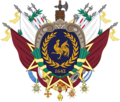Midrasian Chartism: Difference between revisions
mNo edit summary |
|||
| Line 9: | Line 9: | ||
==History== | ==History== | ||
[[image:Charles-Alexandre de Calonne - Vigée-Lebrun 1784.jpg|thumb|right|250px|Patrice Malouines was an influential figure in the drafting of the Midrasian constitution and the first post-revolution Consul]] | [[image:Charles-Alexandre de Calonne - Vigée-Lebrun 1784.jpg|thumb|right|250px|Patrice Malouines was an influential figure in the drafting of the Midrasian constitution and the first post-revolution Consul]] | ||
The origins of Midrasian Chartism can be traced back to the Old Midrasian Republic following the [[History of Midrasia#Civil_War|Midrasian Civil War]]. The first document which could be regarded as an official | The origins of Midrasian Chartism can be traced back to the Old Midrasian Republic following the [[History of Midrasia#Civil_War|Midrasian Civil War]]. The first document which could be regarded as an official constitution for the newfound republic was known as the [[Constitution of Midrasia|Instrument of Government]]. This document set out the operating procedure of the new state, as well as the powers endowed to parliament and the Consul. However, the document itself placed a considerable amount of power in the hands of the Consul, effectively making parliament a 'rubber-stamping' body for the Consul's agenda. Though the decision to create a powerful executive was rooted in the instability the republic faced following the civil war, over time considerable opposition grew to the current settlement, with many viewing the Consul as merely a continuation of the previous despotic [[Monarchy of Midrasia|monarchy]]. | ||
==Overview== | ==Overview== | ||
Revision as of 10:50, 20 February 2020
This article is incomplete because it is pending further input from participants, or it is a work-in-progress by one author. Please comment on this article's talk page to share your input, comments and questions. Note: To contribute to this article, you may need to seek help from the author(s) of this page. |
 |
|---|
| This article is part of a series on the politics and government of Midrasia |
Midrasian Chartism, sometimes referred to as simply Chartism is a variant of liberalism most prominent in Midrasia, but also present in a number of democracies throughout central Asura and other former Asuran colonies, particularly in Rennekka and Vestrim. The ideology is similar to classical liberalism in its promotion of civil liberties under the rule of law whilst emphasising strong economic freedoms with little intervention from the central state in the economy. Importantly however, Chartism is notable for its emphasis on retaining the role of the church for creating a moral society, as well as promoting a gradualist approach to democratisation, sometimes characterised as 'democracy from above' or 'gentry democracy'.
The term Chartist in Midrasia originally referred to anybody under the Old Republic who supported the creation of a Consitutional Charter to limit the power of the Consul whilst also empowering the legislature and codifying a set of rights and liberties enjoyed by all citizens. With the creation of a Midrasian constitution in 1791 the Chartist faction formed a new government under the leadership of Patrice Malouines creating the basis of an official Chartist Party which coalesced in the mid 1830s.
Though the Chartist Party of Midrasia collapsed during the 1870s its ideology and ideals continued to be upheld by a number of other political parties such as the Liberal League and the newly formed Republican Party. Ultimately, in 1902 with the creation of the 'New Political Settlement' which sought to end decades of political division and instability, the Chartist name was revived for the newly formed Chartist Bloc which now represents a wide spectrum of Midrasian centre-right to right-wing beliefs. Not all parties who subscribe to the bloc can be regarded as ideologically Chartist, however those which have historically been successful within the bloc adhere to policies compatable with traditional Chartism.
History
The origins of Midrasian Chartism can be traced back to the Old Midrasian Republic following the Midrasian Civil War. The first document which could be regarded as an official constitution for the newfound republic was known as the Instrument of Government. This document set out the operating procedure of the new state, as well as the powers endowed to parliament and the Consul. However, the document itself placed a considerable amount of power in the hands of the Consul, effectively making parliament a 'rubber-stamping' body for the Consul's agenda. Though the decision to create a powerful executive was rooted in the instability the republic faced following the civil war, over time considerable opposition grew to the current settlement, with many viewing the Consul as merely a continuation of the previous despotic monarchy.
